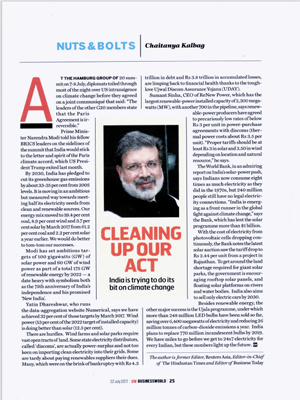CLEANING UP OUR ACT( India is trying to do its bit on climate change )
[Business World]
Published date: 22 Jul 2017
At the Hamburg group of 20 summit on 7-8July, diplomats toiled through most of the night over US intransigence on climate change before they agreed on a joint communique that said: “The leaders of the other G20 members state that the Paris Agreement is irreversible.”
Prime Minister Narendra Modi told his fellow BRICS leaders on the side lines of the summit that India would stick to the letter and spirit of the Paris climate accord, which US President Trump exited last month.
By 2030, India has pledged to cut its greenhouse gas emissions by about 33-35 per cent from 2005 levels. It is movingin an ambitious but measured way towards meeting half its electricity needs from clean and renewable sources. Our energy mix moved to 59.4 per cent coal, 8.9 per cent wind and 3.7 per cent coal and 2.2 per cent solar a year earlier. We would do better to tom-tom our successes.
Modi has set ambitious tar gets of 100 gigawatts (GW) of solar power and 60 GW of wind power as part of a total 175 GW of renewable energy by 2022 – a date heavy with symbolism both as the 75th anniversary of lndia’s independence and his promised ‘New India’.
Yatin Dhareshwar, who runs the data-aggregation website Numerical, says we have achieved 32 per cent of those targets by March 2017. Wind power (53per cent of the 2022 target of installed capacity) is doing better than solar (12.5 per cent).
There are hurdles. Wind farms and solar parks require vast open tracts of land.Some state electricity distributors, called’ discoms’, are actually power-surplus and not too keen on importing clean electricity into their grids. Some are tardy about paying renewables suppliers their dues. Many, which were on the brink of bankruptcy with Rs 4.3 trillion in debt and Rs 3.8 trillion in accumulated losses, are limping back to financial health thanks to the tough love Ujwal Discom Assurance Yojana (UDAY).
Sumant Sinha, CEO of ReNew Power, which has the largest renewable-power installed capacity of 2,300 mega watts (MW), with another 700 in the pipeline, says renewable-power producers have agreed to precariously low rates of below Rs 3 per unit in power-purchase agreements with discoms (thermal power costs about Rs 3.5 per unit). “Proper tariffs should be at least Rs3 in solar and 3.50 in wind depending on location and natural resource,” he says.
The World Bank, in an admiring report on India’s solar-power push, says Indians now consume eight times as much electricity as they did in the 1970s, but 240 million people still have no legal electricity connections. “India is emerging as a front runner in the global fight against climate change,” says the Bank, which has lent the solar programme more than $1 billion.
With the cost of electricity from photovoltaic cells dropping continuously, the Bank notes the latest solar auction saw the tariff drop to Rs 2.44 per unit from a project in Rajasthan. To get around the land shortage required for giant solar parks, the government is encouraging rooftop solar panels, and floating solar platforms on rivers and water bodies. India also aims to sell only electric cars by 2030.
Besides renewable energy, the other major success is the Ujala programme, under which more than 248million LED bulbs have been sold so far, saving over 6,400 megawatts of electricity and reducing 26 million tonnes of carbon-dioxide emissions a year. India plans to replace 770 million incandescent bulbs by 2019. We have miles to go before we get to 24×7 electricity for every Indian, but these numbers light up the future.






